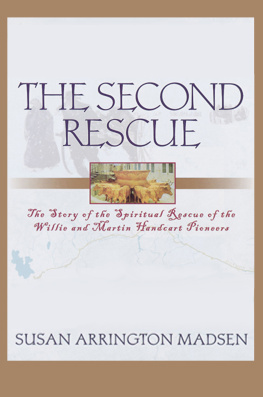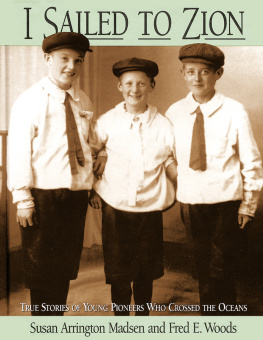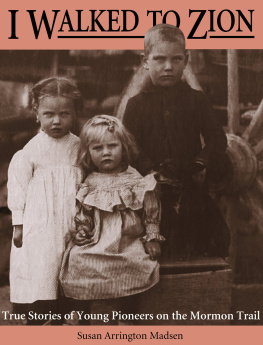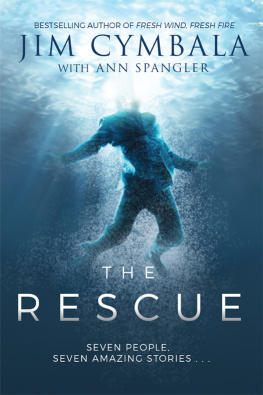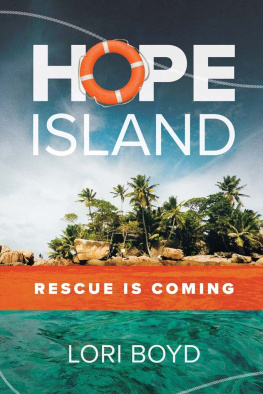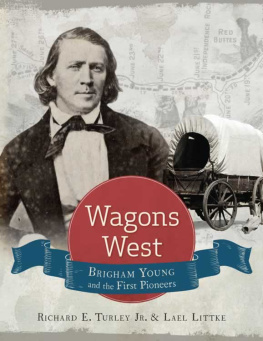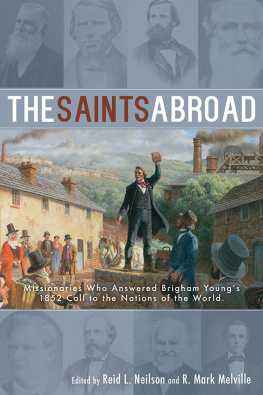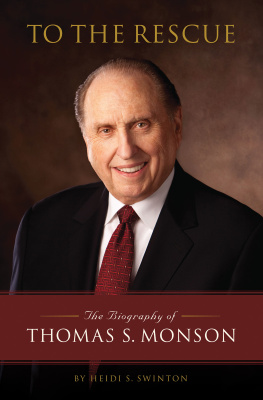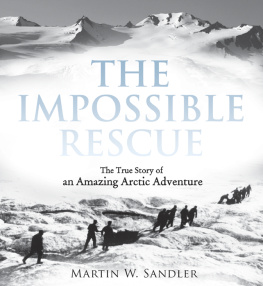The Second Rescue
The Story of the Spiritual Rescue of the Willie and Martin Handcart Pioneers
Susan Arrington Madsen
1998 Susan Arrington Madsen.
All rights reserved. No part of this book may be reproduced in any form or by any means without permission in writing from the publisher, Deseret Book Company, P.O. Box 30178, Salt Lake City Utah 30178. This work is not an official publication of The Church of Jesus Christ of Latter-day Saints. The views expressed herein are the responsibility of the author and do not necessarily represent the position of the Church or of Deseret Book. Deseret Book is a registered trademark of Deseret Book Company.
Visit us at DeseretBook.com
Library of Congress Cataloging-in-Publication Data
Madsen, Susan Arrington.
Second rescue/Susan Arrington Madsen.
p. cm.
Includes bibliographical references and index.
ISBN 1-57345-362-5 (hb)
1. MormonsWyomingBiography. 2. PioneersWyomingBiography. 3. Mormon Trail. 4. Temple work (Mormon Church) 5. Church of Jesus Christ of Latter-day Saints. Riverton Wyoming StakeHistory. 6. Mormon ChurchWyomingRiverton RegionHistory. 7. Riverton Region (Wyo.)Church history. 8. WyomingBiography. I. Title.
BX8693.M327 1998
289.30922dc21
[B] 97-49662
CIP
Printed in the United States of America
10 9 8 7 6 5 4 3 2 1
72082 - 6266
To the members of the Riverton Wyoming Stake, The People of the Second Rescue
Blessed art thou, Nephi, for those things which thou hast done; for I have beheld how thou hast with unwearyingness declared the word, which I have given unto thee, unto this people. And thou hast not feared them, and hast not sought thine own life, but hast sought my will, and to keep my commandments.
And now, because thou hast done this with such unwearyingness, behold, I will bless thee forever...
HELAMAN 10:45
PREFACE
Occasionally an event or even a single moment comes along that significantly changes the way a person views the past. Such an event occurred for me on November 15, 1996. On that day, my husband, Dean, and I visited for the first time various sites in central Wyoming along the Mormon Trail. We were led by Robert Scott Lorimer, president of the Riverton Wyoming Stake and guide extraordinaire for sites of particular significance to the James G. Willie and Edward Martin handcart companies of 1856.
After a chilly, breezy day of exploring Independence Rock, Devils Gate, the Sun Ranch, and Martins Cove, we headed for Rocky Ridge, some sixty-five miles to the west. It was there that my feelings, my empathy, for the weary and stranded pioneers sank especially deep.
Rocky Ridge is well named. Just as prophets, apostles, and other eager latter-day visitors have done, we drove up the steep, bumpy trail as far as we could go in President Lorimers Suburban. With each jolt and swerve I asked myself, How in the world did those exhausted, hungry, freezing souls get their carts and wagons up this rocky incline?
On the day of our visit to Rocky Ridge, there were several inches of snow on the ground, making the trail somewhat forbidding. Twice the vehicle became stuck, and it was with some effort that we were able to push and shove the Suburban on its way again. The last time, about a half mile from the summit, President Lorimer suggested it would be best if the three of us walked the rest of the way. It was cold, it was still, and there was a beautiful moon in the sky as we walked and shared stories of the perilous situation that faced the Willie and Martin handcart pioneers in October of 1856. There was much talk of Captain Willie, Joseph Elder, and Ephraim Hanks. We also remembered Ann Rowley, Archibald McPhail, and little Mary Hurren.
Upon reaching the summitat 7300 feet, one of the highest points along the entire Mormon Trailwe admired the monument built there by members of the Riverton Wyoming Stake. A few more stories, and it was time to return to the car. By then the scene had changed somewhat. The sky had clouded over, and the light of the moon was gone. Although we were dressed warmly, we had not remembered to bring a flashlight. It was very, very dark; no lights were to be seen in any direction.
For fifteen minutes, which somehow seemed much longer, we tried to find our way back to President Lorimers Suburban. We missed one important turn and had to backtrack through the desolate, rocky terrain to find the right trail. We were alone in the blackness, in the middle of nowhere. The silence spoke volumes about our isolation, our exposure to the elements, our vulnerability. There was no help nearby and the wind was kicking up again.
Thanks to President Lorimers intimate knowledge of the terrain, we soon found the car. It was a welcome sight. Within minutes we were driving back down the bumpy trail, munching on Dee Lorimers famous chocolate-chip cookies, the warm heater humming. Safe again.
Our moment of uncertainty was ridiculously short compared to the weeks of terror and hardship experienced by hundreds of pioneer mothers and fathers. Mile after mile they comforted their little ones along the treacherous, snowy path. Death was constantly knocking at their door. As we drove through the darkness back to Riverton, President Lorimer apologized for the inconvenience on Rocky Ridge. I expressed to him, however, my deep gratitude for those few brief moments of isolation and fear. Because of those moments, I understand the strength and faith of the pioneers better now, and I love them even more.
That first trip to central Wyoming changed my life in other ways. I became acquainted, for example, with the people of the Riverton Wyoming Stake who participated in the project now known as the Second Rescue. It has been a privilege to witness their humility, to feel their love for the handcart people, and to sense their gratitude for being involved in this sacred, Spirit-led project. It has been an honor to compile a book on their experiences. Many sacred and memorable stories were given to me that could not be included in the final book. Those stories are forever recorded in the hearts and souls of those who participated.
Several excellent books and hundreds of fine articles have been published on the Mormon hand-cart experience. This book does not attempt to duplicate their contributions. Instead, The Second Rescue tells how the Lord led the present-day Saints of the Riverton Wyoming Stake to discover that more than half of the temple ordinances for those heroic 1856 pioneers and their families were not yet done. It also describes their discovery of what the Lord wanted the Wyoming Saints to do about it, and what the remarkable fruits of their obedience to the Spirit were.
In this book, representative stories of the Willie, Martin, Hunt, and Hodgett companies of 1856 appear as sidebars alongside the main text. Stories of the faith and sacrifice of these early pioneers are included because they are important to our understanding of the spiritual significance of the Second Rescue. These accounts will also help those who read the book understand the deep love and attachment the people who participated in the Second Rescue feel for these remarkable pioneers.
My role has been that of compiler, abridger, and storyteller. President R. Scott Lorimer, untiring in his efforts, has provided me with the equivalent of a small truckload of materials from which to tell this remarkable story. He has promptly answered my many letters, phone calls, and questions, enabling me to clarify the text and forge ahead with the writing of the manuscript. He has served as advisor, editor, and cheerleader for this project. He loves the people of the Riverton Wyoming Stake, and has a deep and personal love for the pioneers.

